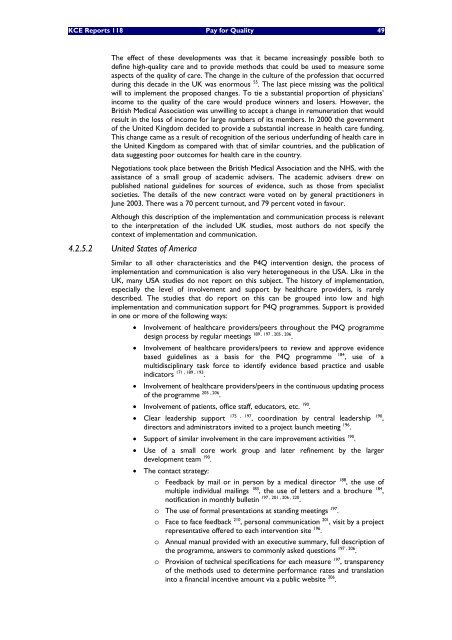Pay for Quality
Pay for Quality
Pay for Quality
Create successful ePaper yourself
Turn your PDF publications into a flip-book with our unique Google optimized e-Paper software.
KCE Reports 118 <strong>Pay</strong> <strong>for</strong> <strong>Quality</strong> 49<br />
The effect of these developments was that it became increasingly possible both to<br />
define high-quality care and to provide methods that could be used to measure some<br />
aspects of the quality of care. The change in the culture of the profession that occurred<br />
during this decade in the UK was enormous 55 . The last piece missing was the political<br />
will to implement the proposed changes. To tie a substantial proportion of physicians’<br />
income to the quality of the care would produce winners and losers. However, the<br />
British Medical Association was unwilling to accept a change in remuneration that would<br />
result in the loss of income <strong>for</strong> large numbers of its members. In 2000 the government<br />
of the United Kingdom decided to provide a substantial increase in health care funding.<br />
This change came as a result of recognition of the serious underfunding of health care in<br />
the United Kingdom as compared with that of similar countries, and the publication of<br />
data suggesting poor outcomes <strong>for</strong> health care in the country.<br />
Negotiations took place between the British Medical Association and the NHS, with the<br />
assistance of a small group of academic advisers. The academic advisers drew on<br />
published national guidelines <strong>for</strong> sources of evidence, such as those from specialist<br />
societies. The details of the new contract were voted on by general practitioners in<br />
June 2003. There was a 70 percent turnout, and 79 percent voted in favour.<br />
Although this description of the implementation and communication process is relevant<br />
to the interpretation of the included UK studies, most authors do not specify the<br />
context of implementation and communication.<br />
4.2.5.2 United States of America<br />
Similar to all other characteristics and the P4Q intervention design, the process of<br />
implementation and communication is also very heterogeneous in the USA. Like in the<br />
UK, many USA studies do not report on this subject. The history of implementation,<br />
especially the level of involvement and support by healthcare providers, is rarely<br />
described. The studies that do report on this can be grouped into low and high<br />
implementation and communication support <strong>for</strong> P4Q programmes. Support is provided<br />
in one or more of the following ways:<br />
• Involvement of healthcare providers/peers throughout the P4Q programme<br />
design process by regular meetings 189 , 197 , 205 , 206 .<br />
• Involvement of healthcare providers/peers to review and approve evidence<br />
based guidelines as a basis <strong>for</strong> the P4Q programme 184 , use of a<br />
multidisciplinary task <strong>for</strong>ce to identify evidence based practice and usable<br />
indicators 171 , 189 , 193 .<br />
• Involvement of healthcare providers/peers in the continuous updating process<br />
of the programme 205 , 206 .<br />
• Involvement of patients, office staff, educators, etc. 190 .<br />
• Clear leadership support 175 , 197 , coordination by central leadership 190 ,<br />
directors and administrators invited to a project launch meeting 196 .<br />
• Support of similar involvement in the care improvement activities 190 .<br />
• Use of a small core work group and later refinement by the larger<br />
development team 190 .<br />
• The contact strategy:<br />
o Feedback by mail or in person by a medical director 188 , the use of<br />
multiple individual mailings 183 , the use of letters and a brochure 184 ,<br />
notification in monthly bulletin 197 , 201 , 206 , 220 .<br />
o The use of <strong>for</strong>mal presentations at standing meetings 197 .<br />
o Face to face feedback 210 , personal communication 201 , visit by a project<br />
representative offered to each intervention site 196 .<br />
o Annual manual provided with an executive summary, full description of<br />
the programme, answers to commonly asked questions 197 , 206 .<br />
o Provision of technical specifications <strong>for</strong> each measure 197 , transparency<br />
of the methods used to determine per<strong>for</strong>mance rates and translation<br />
into a financial incentive amount via a public website 206 .
















